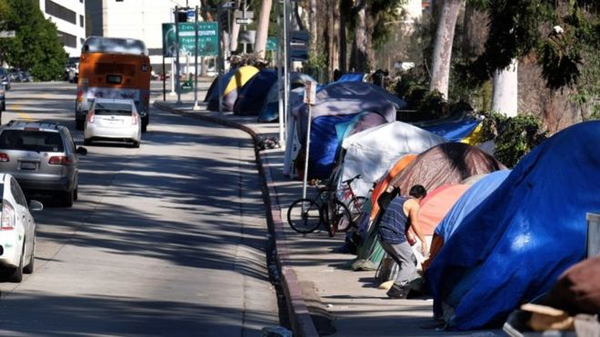
Homelessness in Los Angeles increased by 23 percent over the last year, and city officials, activists and non-profit organizations are working to solve the crisis.
According to the 2017 Greater Los Angeles Homeless Count, mandated by the U.S. Department of Housing and Urban Development, the homeless population rose from 46,874 in 2016 to 57,794 this year.
Every year, during the last 10 days of January, volunteers hit the streets to count individuals and families in sheltered and unsheltered public and private spaces.
Homelessness in the Antelope Valley (AV) and East L.A. County went up 50 percent. The San Gabriel Valley went up 31 percent, while Metro L.A. saw a 30 percent jump.
South L.A. rose 24 percent, West L.A. 18 percent, and South Bay and the San Fernando Valley both went up four percent.
“We have business to do,” said Mark Ridley-Thomas, chairman of the L.A. County Board of Supervisors.
“No hand-wringing, no fretting, no ‘woe is me’ – it’s just simply time to roll up our sleeves and do what we know needs to be done. You’ve got to be ready to fight to end homelessness in the County of Los Angeles,” Ridley-Thomas stated during a recent press conference organized by the Los Angeles Homeless Services Authority.
In the City of Los Angeles, 34,189 people experience homelessness on a given night, according to the 2017 Homeless Count. That represents a 20 percent increase from 28,464 in 2016.
Ridley-Thomas said voters’ passage of Measure H in March and Proposition HHH in November has afforded L.A. an opportunity to step forward with imagination, compassion, and resources to confront the issue facing L.A. County.
“I am not at all discouraged by this (Homeless Count),” Ridley-Thomas added. “Many of us sensed that there was an uptick, and these numbers validate that. The good news is that we have the capacity, for the first time, to stand up to it,” he said.
A key solution is Measure H 1/4-cent sales tax, Ridley-Thomas and others say. According to a release issued by his office, Measure H is “expected to raise $355 million annually for services to the homeless countywide. It creates an unprecedented funding stream expected to move 45,000 homeless men, women and children into stable housing within the next five years, and provide them with the high-quality, multi-dimensional supportive services they need to succeed in the long run.”
“We have no excuse not to do our very best because we are now equipped,” Ridley-Thomas said.
At press time, the Board of Supervisors was preparing for a June 13 hearing on the final report of a planning group that is developing funding recommendations for the first three years of Measure H, according to Ridley-Thomas’ staff.
They informed that core strategies earmarked for July 1 implementation include outreach to the homeless through engagement teams; providing permanent housing with healthcare and other services; expanding rapid rehousing for the newly homeless; enhancing the emergency shelter system, including for those leavings jails and hospitals; and strengthening the network of community nonprofits already serving homeless single adults, families and youth.
“This planning effort has not been done in haste,” Ridley-Thomas said. “It is a reflection of years of work, principally by the City of Los Angeles and the County of Los Angeles with the input of thousands of stakeholders, to develop plans to deal with homelessness in a collaborative way,” he continued.
Councilman Marqueece Harris-Dawson (8th District), who also attended the press conference, said the increase in homelessness is alarming and disheartening.
“After housing nearly 10,000 individuals, we still face an increase of homelessness. Our housing crisis is feeding the homeless problem even faster than we can house people. We need to fully fund our affordable housing while at the same time making sure HHH is aggressively implemented. We can’t allow working people in our community to become homeless as rent increases explode,” Harris-Dawson stated.
General Jeff Paige, Skid Row activist, said reports of increased homelessness in L.A. is nothing new.
“The 2017 Homeless Count, all it does is confirm what we already know and what we’ve been hollering and crying about for many years now, saying this was coming. This was coming! This was coming,” Paige emphasized.
“This confirms it, and we’re not shocked! We’re highly disappointed and we’re highly frustrated, because this is more of a reactionary system. They react once the problem happens, and don’t do enough to prevent it from happening,” Paige stated.
Homelessness will continue to explode at an alarming rate by the next 10-15 years, Paige predicted.
Skid Row residents attempted to create the Skid Row Neighborhood Council to address the issue and help solve other problems and needs there, but that was voted down in an election last month.
According to Paige, Skid Row was subjected to votes from the entire Downtown L.A. area and lost by 60 votes.
Paige stated the Neighborhood Council would have given Skid Row its own governing body and “a direct connection to the city’s resources, so that we can help get our lost brothers and sisters off the streets and get them the services and create the solutions that we know will work for them, as opposed to what the system is trying to say will work for them.”
Meanwhile, elected officials and national housing advocates were planning to host a press call on June 8 to address the nationwide study of the gap between renters’ wages and the cost of housing.
“Out of Reach 2017: The High Cost of Housing” documents the mismatch between renters’ wages and the cost of rental housing, according to organizers. Speakers include U.S. Representative Keith Ellison (D-MN), Diane Yentel, president and CEO, National Low Income Housing Coalition, and Andrew Aurand, vice president for Research, National Low Income Housing Coalition.






